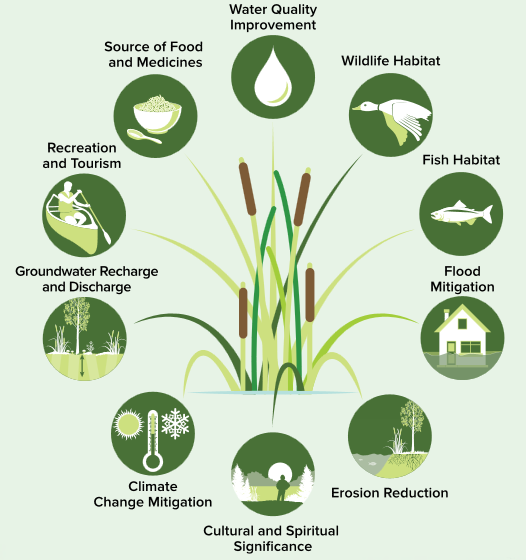Managing ecosystem services in agricultural landscapes
Prairie landscapes have been used for food for centuries. They also offer a myriad of other services that are key to understanding their landscapes management.
By Emily Cavaliere and Jared Wolfe
The Canadian Prairies are often considered the “bread basket” of Canada. During the 2019/20 production period, the Prairie Provinces accounted for 78% of Canada’s total crop yield1. In order to provide such levels, much of the landscape is managed to maximize efficiencies in the production of food. Food production and sale serves as a living for farmers, ranchers, and producers. Moreover, agriculture provides a lifestyle or culture that is central to the identity of many prairies peoples.
An “ecosystem service” is an umbrella term describing the benefits people, communities, and society receive from nature. What those benefits are and how much are given depends on a host of factors:
- What type of ecosystem is generating them?
- When and where are they being provided? Who is (or is not) on the receiving end of the service or benefit?
- What defines a “service” also varies, and can refer to a commodity or good (provisioning), regulating habitable conditions (regulating), non-material value (cultural), or supportive?2
The food provided and cultural value affirmed by agricultural landscapes can be considered as ecosystem services and a benefit to people and communities.
On the other hand, when we manage for a single or a few services, we can overlook or negatively impact others. For example, grassland and wetland conversion to cropland can enhance food production in the short-term. Yet, this conversion can come at the expense of other services, like maintenance of biodiversity, or processes that maintain water quality and groundwater recharge. The resulting trade-offs are important to understand and manage to ensure future sustainable food systems and environment.
Within the Prairie Water group, we are developing a framework to assess changes to ecosystem services. Our approach is to create an integrate system that connects our understanding of different processes that produce ecosystem services on the Canadian Prairies. Through this approach, we can better understand how different approaches to policy or water management can optimize ecosystems service production across the diversity of prairie landscapes and into the future.
Who bares the cost of different practices and who benefits? How can we best manage watersheds to optimize the services they provide? How do these processes differ under future climate change? These are crucial questions to understand how management decisions today impact future ecosystem services.
Click the embedded video below to learn more about her research into how we are developing a new approach to assess prairie ecosystem services.
Endnotes
1 Over the 2019/20 period, Alberta, Saskatchewan, and Manitoba cumulatively produced 73.08 million tonnes of crop. This is out of 93.41 million tonnes produced across Canada over the same period. The Prairie Provinces accounted for 27.89 million hectares of seeded area out of the total 32.02 million hectares in Canada, or 87% of total seeded area in Canada. Information was obtained from Agriculture and Agri-Food Canada, 2 June 2020, https://aimis-simia.agr.gc.ca/rp/index-eng.cfm?action=pR&PDCTC=&R=243&E=1#clfinput_err
2 The Ecosystem Services Toolkit provides more information on how to define and assess ecosystem services.
Authors

Dr. Emily Cavaliere is a Postdoctoral researcher at the University of Saskatchewan and part of the team leading the charge to integrate our understanding of prairie watershed science.

Jared Wolfe is the project manager for the Prairie Water project. His background is in aquatic ecosystem science, with a particular interest in the inferface between science, management, and policy. He currently works to facilliate linkages between researchers and young research professionals with practitioners on aspects of water security.

